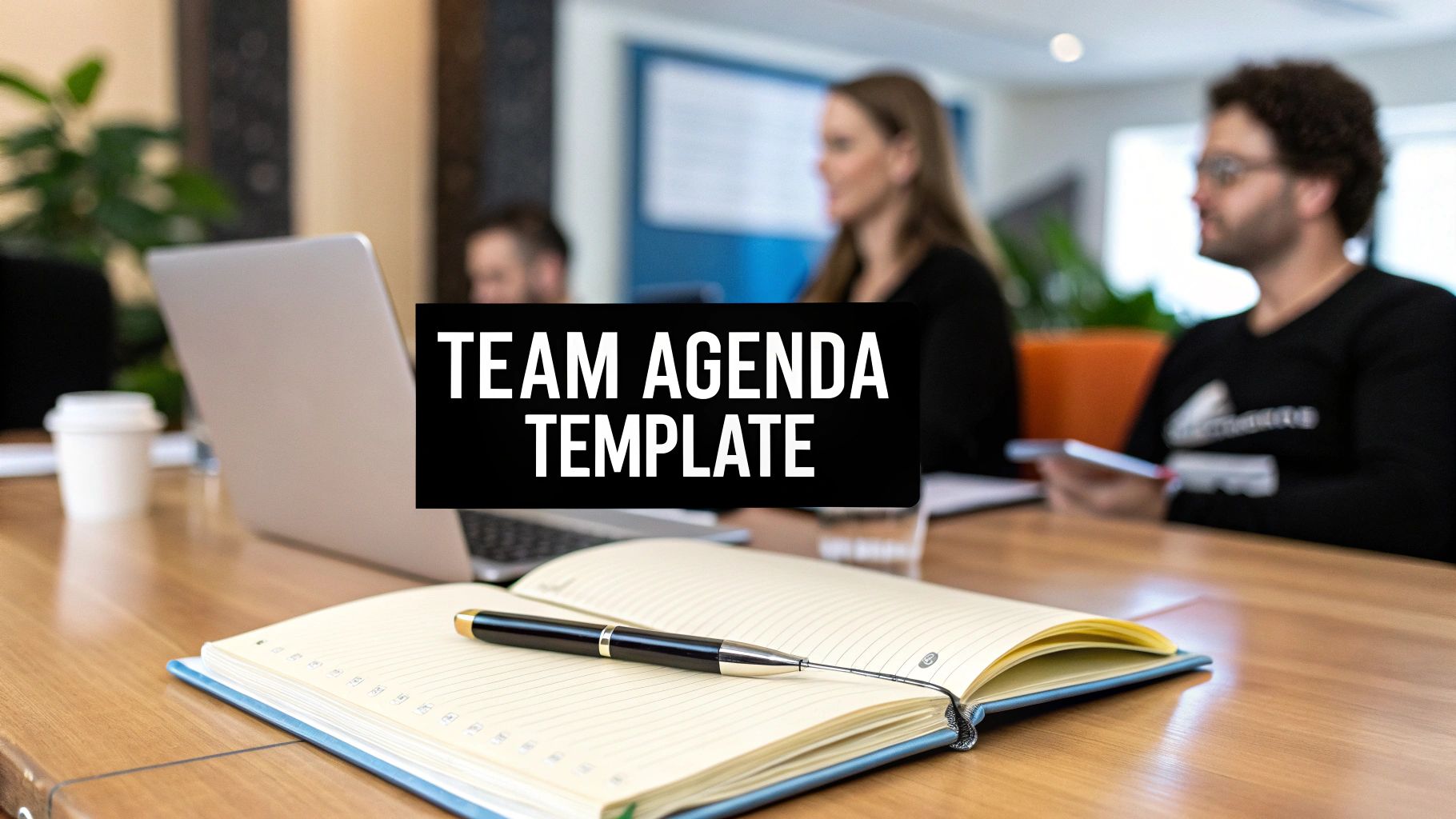If there's one tool that can single-handedly rescue your team's meetings from the brink of chaos, it's a solid team meeting agenda template. It’s the difference between a focused, action-oriented session and another hour of your life you'll never get back. An agenda provides structure, sets clear expectations, and ultimately, respects everyone's time.
Why Most Team Meetings Don't Work
Let’s be real for a moment—we’ve all been there. The meeting that starts ten minutes late, meanders through a dozen unrelated rabbit holes, and wraps up with a vague "we'll circle back on this." It's not just frustrating; it's a massive drain on your team's energy and productivity.
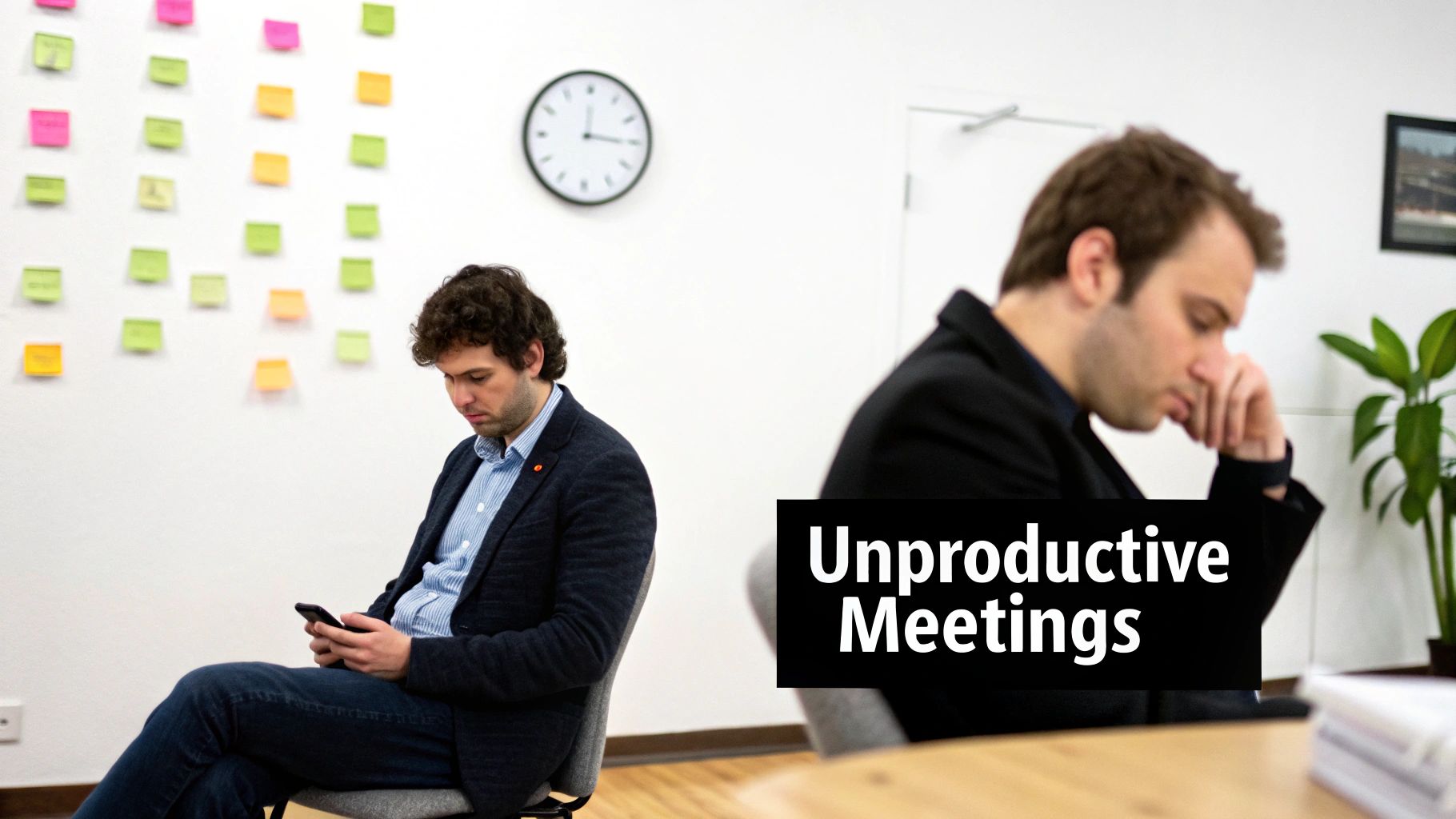
The old habit of just "winging it" is a recipe for disaster in today's work environment, particularly with hybrid teams where clear communication is everything. Without a plan, conversations drift, people who need to contribute aren't prepared, and important decisions get punted to the next meeting… and the next.
The Real Cost of Unstructured Meetings
The fallout from bad meetings goes far beyond simple annoyance. It carries a real financial cost and is a huge driver of employee disengagement. When a meeting has no clear purpose, team members mentally check out, start multitasking, or wonder why they were even invited.
This isn't a small problem. Recent research shows that the average employee now spends 11.3 hours per week in meetings, a number that has shot up threefold since 2020. With meeting time costing businesses around $29,000 per employee each year, it's no wonder companies are scrambling to make this time count. You can dig into more of these numbers and how meeting statistics impact the modern workplace on archieapp.co.
An agenda transforms a meeting from a passive update into an active work session. It’s the difference between talking about work and actually getting work done together.
A well-designed team meeting agenda template acts as a roadmap, forcing the organizer to think through the meeting's why and desired outcomes before anyone even clicks "accept." This simple, proactive step brings clarity and helps you sidestep common meeting pitfalls, like:
- Scope Creep: When a discussion on Q3 marketing goals suddenly becomes a debate about the office coffee brand.
- Decision Paralysis: The all-too-common scenario of ending a meeting without any clear, actionable next steps.
- Unequal Participation: Where remote team members struggle to get a word in, feeling more like spectators than participants.
- Lack of Preparation: Attendees showing up cold, without the context needed to offer valuable input.
Building Your Foundational Meeting Agenda
Ready to build a team meeting agenda template that people actually use? Let’s be honest, moving from unstructured chaos to focused collaboration doesn't happen by accident. It requires a solid blueprint. This isn't just about jotting down a few topics; it's about architecting a conversation with a clear beginning, middle, and end.
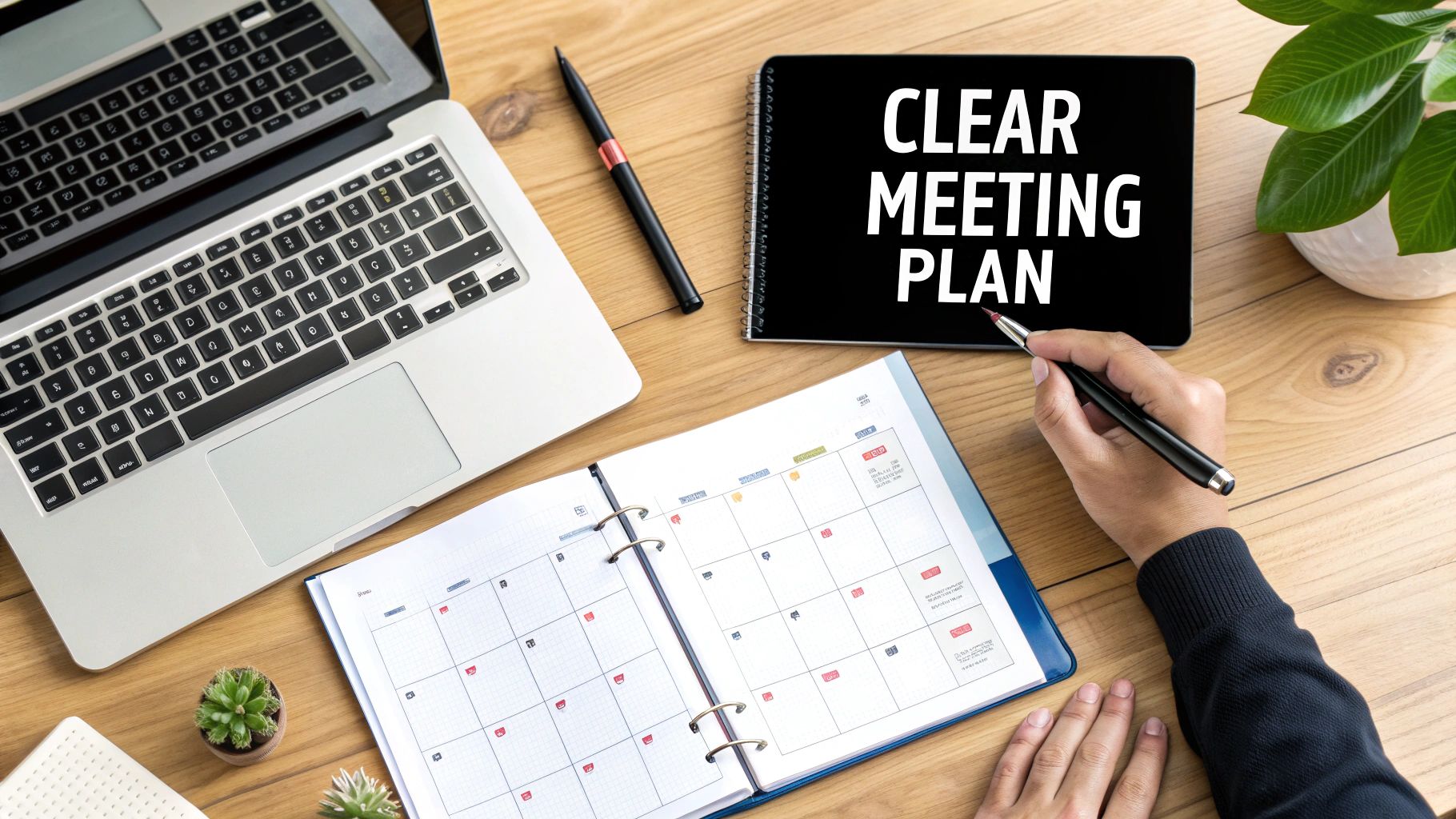
The foundational elements are your non-negotiables. From my experience, every truly effective agenda starts with a single, clear objective. Ask yourself: what is the one thing we absolutely must achieve by the end of this meeting? This goal becomes your North Star, guiding every single item you add.
Defining Key Roles and Responsibilities
Before you even think about discussion points, assign a few key roles. It’s a simple step, but it’s amazing how much it helps distribute ownership and keep the meeting running smoothly. When there are no assigned roles, the meeting organizer often ends up juggling everything, which is a recipe for dropped balls and unfocused discussions.
I recommend always including these roles in your template:
- Facilitator: This person guides the conversation, keeps everyone on track, and makes sure all voices are heard. Pro tip: it doesn't always have to be the manager! Rotating this role is a great way to build leadership skills across the team.
- Note-Taker: Their job is to document key decisions, action items, and important points, which frees everyone else up to fully participate in the conversation.
- Timekeeper: This person gently reminds the team of the time allocated for each item. It’s a small thing, but it’s crucial for maintaining momentum and respecting everyone's schedule.
When everyone has a part to play, they're engaged right from the start.
Structuring Your Agenda Items
Once the roles are set, you can get into the core of your agenda. The best templates I've seen organize items logically to build momentum. A good flow prevents jarring context-switching and helps the team make better, more thoughtful decisions. Think of it like a story: you need an introduction, the main plot, and a clear conclusion.
A great agenda doesn't just list what you'll talk about; it clarifies the desired outcome for each topic. Are you seeking a decision, gathering feedback, or just sharing information?
For example, instead of a vague item like "Q3 Marketing Campaign," frame it as an action. Try something like, "Decide on the primary channel for the Q3 marketing campaign (15 mins)." This immediately tells attendees what's expected of them and how much time they have. If you're looking for some real-world inspiration, this collection of 15 meeting agenda examples and templates is a great place to start.
This kind of structure brings much-needed clarity. Even small details, like providing great food for a lunch meeting, can help set a positive and productive tone. Having a reliable partner for your office catering can make these moments seamless and genuinely enjoyable for everyone.
Essential Components of a High-Impact Meeting Agenda
So, what are the non-negotiables your team meeting agenda template needs to drive focused conversations? I've put together a quick look at the core components that should form the backbone of any template you create. This blueprint is designed to be adaptable for any meeting, from a weekly check-in to a major project kickoff.
| Component | What It Achieves | Example in Practice |
|---|---|---|
| Meeting Goal | Provides a single, clear purpose for the meeting. | "Finalize the Q4 budget allocation for the engineering department." |
| Time Blocks | Ensures the meeting stays on schedule and respects everyone's time. | "Review project milestones (10 min), Discuss roadblocks (15 min)." |
| Topic Owners | Assigns responsibility for leading each discussion point. | "Sarah to lead the discussion on customer feedback." |
| Action Items | Creates a clear record of next steps and accountability. | "Action: Tom to send the revised project timeline by EOD Friday." |
Building these elements into your template from the start will make a massive difference in the quality and outcome of your team's meetings.
Making Your Agenda Work for Hybrid and Remote Teams
Running meetings when your team isn't all in the same room is a whole different ball game. It adds a layer of complexity that can easily leave remote folks feeling disconnected. A truly effective agenda has to be built from the ground up to bridge that physical gap, making sure everyone can contribute equally, whether they're at the head of the conference table or dialing in from their home office.
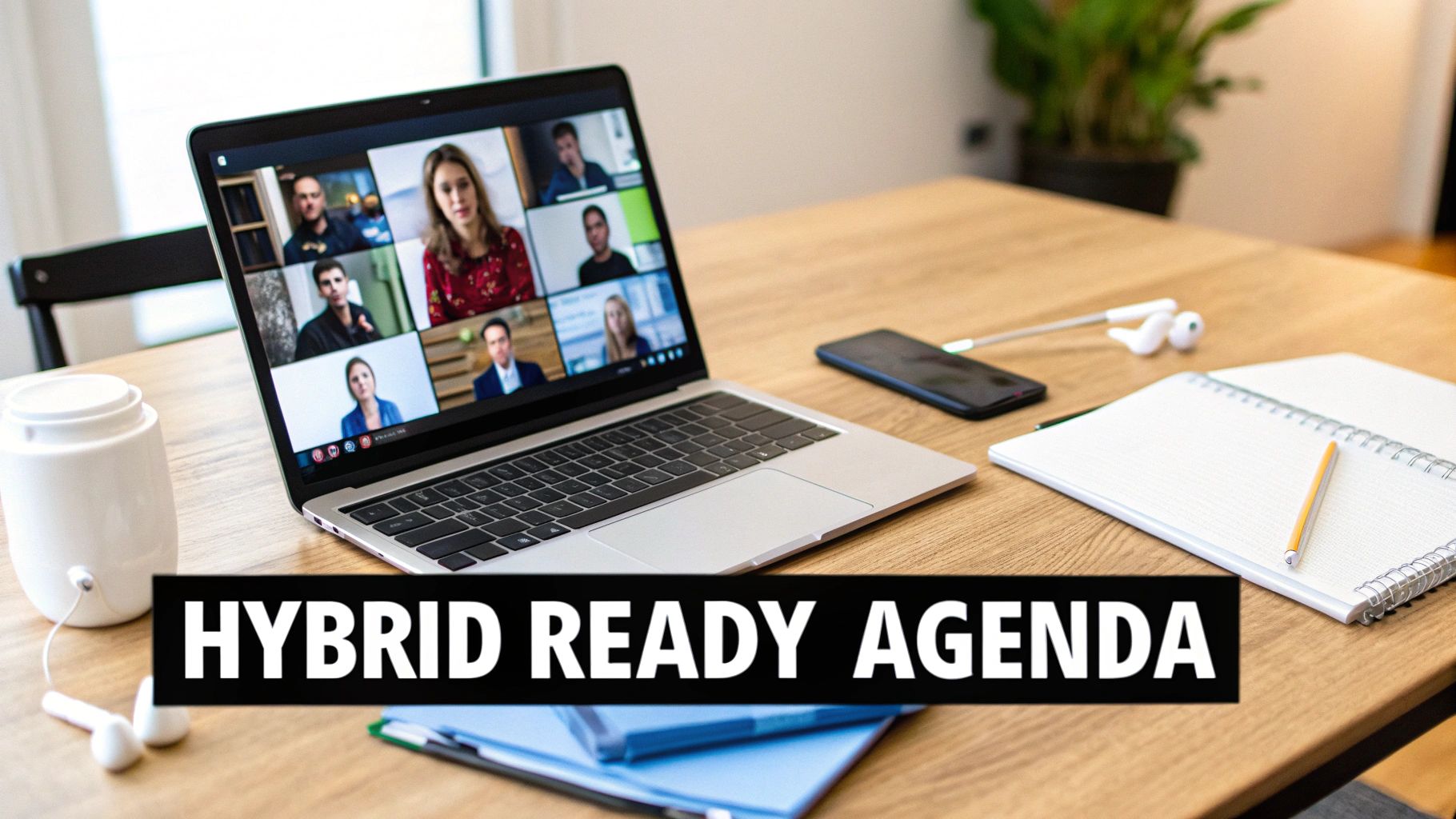
This means doing more than just dropping a Zoom link into the calendar invite. You have to consciously shift the meeting's flow to be digital-first. For example, that classic, freewheeling brainstorming session? It often leaves remote participants on the sidelines, struggling to break into a fast-paced conversation dominated by those in the room.
To get this right, you need to understand the dynamics of office vs. remote work today. Here in Canada, flexible schedules are the new norm, completely changing how we collaborate. It's a widespread shift that makes structured, inclusive agendas more critical than ever for making the most of everyone's time, regardless of where they are.
Building a Digital-First Agenda
To really foster an inclusive environment, your template needs sections specifically designed for digital engagement. Instead of a vague "Discussion" item, try creating dedicated slots for online activities. It’s a small tweak, but it sends a powerful message: online participation is a core part of the meeting, not just an add-on.
Here are a few practical strategies you can build right into your template:
- Structured Digital Feedback: Pencil in a five-minute slot for an integrated poll or a quick survey. This gives everyone—especially the quieter members of your team—a clear, structured way to share their opinion without having to fight for airtime.
- Designated 'Camera-Off' Time: For longer meetings, consciously schedule a brief "camera-off" period. This small break can do wonders to combat video fatigue, giving people a moment to reset. It’s a simple courtesy that’s especially valued by remote attendees who spend their days on camera.
- Asynchronous Pre-Work: Add a section for pre-meeting contributions in a shared document. This is a game-changer for teams spread across different time zones, allowing them to add their thoughts and ideas well before the live discussion even kicks off.
The goal is to create an experience where location becomes irrelevant. Your agenda should be the tool that levels the playing field, ensuring the best ideas win, not just the loudest voice in the conference room.
Advanced Tactics for Truly Effective Meetings
Having a solid team meeting agenda is a great start, but let's be honest—it's just the beginning. To really elevate your meetings from just another calendar block to a session that actually drives progress, you need to go a bit further. These aren't just tricks; they're strategies I've seen work time and again to shape the entire meeting experience.
One of the most powerful shifts you can make is introducing "pre-work." This isn't about assigning homework. It's about flipping the script from a passive "report-out" meeting to an active, problem-solving one. Stop wasting precious face-to-face time on data dumps.
Instead of an agenda item like "Review Q3 Sales Data," try sending out the report beforehand with a specific prompt: "Please look over the attached Q3 sales report and come ready to share one key opportunity you see for Q4." See the difference? Now your meeting is all about high-value discussion, not someone reading numbers off a slide.
Taming Tangents with the Parking Lot
We've all been there. The conversation is flowing, and suddenly a brilliant—but totally off-topic—idea pops up, threatening to derail the entire agenda. You can't just shut down good ideas, but you also can't afford to lose focus. This is where the "parking lot" method is your best friend.
When a tangent appears, the facilitator can just say, "That's a fantastic point. To make sure we give it the time it deserves without getting off track, let's add it to the 'parking lot' for later." This simple act validates the person's contribution while gently steering everyone back to the task at hand. A corner of a whiteboard or a shared digital doc works perfectly for this.
An effective follow-up process is the bridge between discussion and action. Without it, even the best ideas and decisions made in the meeting can fade away without ever being implemented.
Closing the Loop with Clear Follow-Up
This is the part most teams fumble. The meeting doesn't actually end when the clock hits the hour. A truly effective meeting finishes with a clear, concise summary sent out to everyone within a few hours.
Your wrap-up email or message should be scannable and include:
- Key Decisions Made: A simple bulleted list of what was agreed upon.
- Action Items: No ambiguity here. List who is doing what and by when.
- Parking Lot Items: A quick note of the topics you've saved for another time.
This habit creates accountability and makes sure everyone walks away on the same page. Speaking of planning, for bigger corporate events, even details like catering can make a huge impact on the meeting's success. As many Toronto businesses have learned, the right meal choice can really elevate the entire experience—you can see why they choose specific cuisines for corporate events and how it fits into their planning.
Making Your New Agenda a Team Habit
You've designed a brilliant team meeting agenda template. That's the easy part. The real challenge is making sure it doesn't just sit in a shared drive, forgotten. Turning this new document into a genuine team habit requires a bit of strategy—it's about creating shared ownership, not just issuing a new rule from on high.
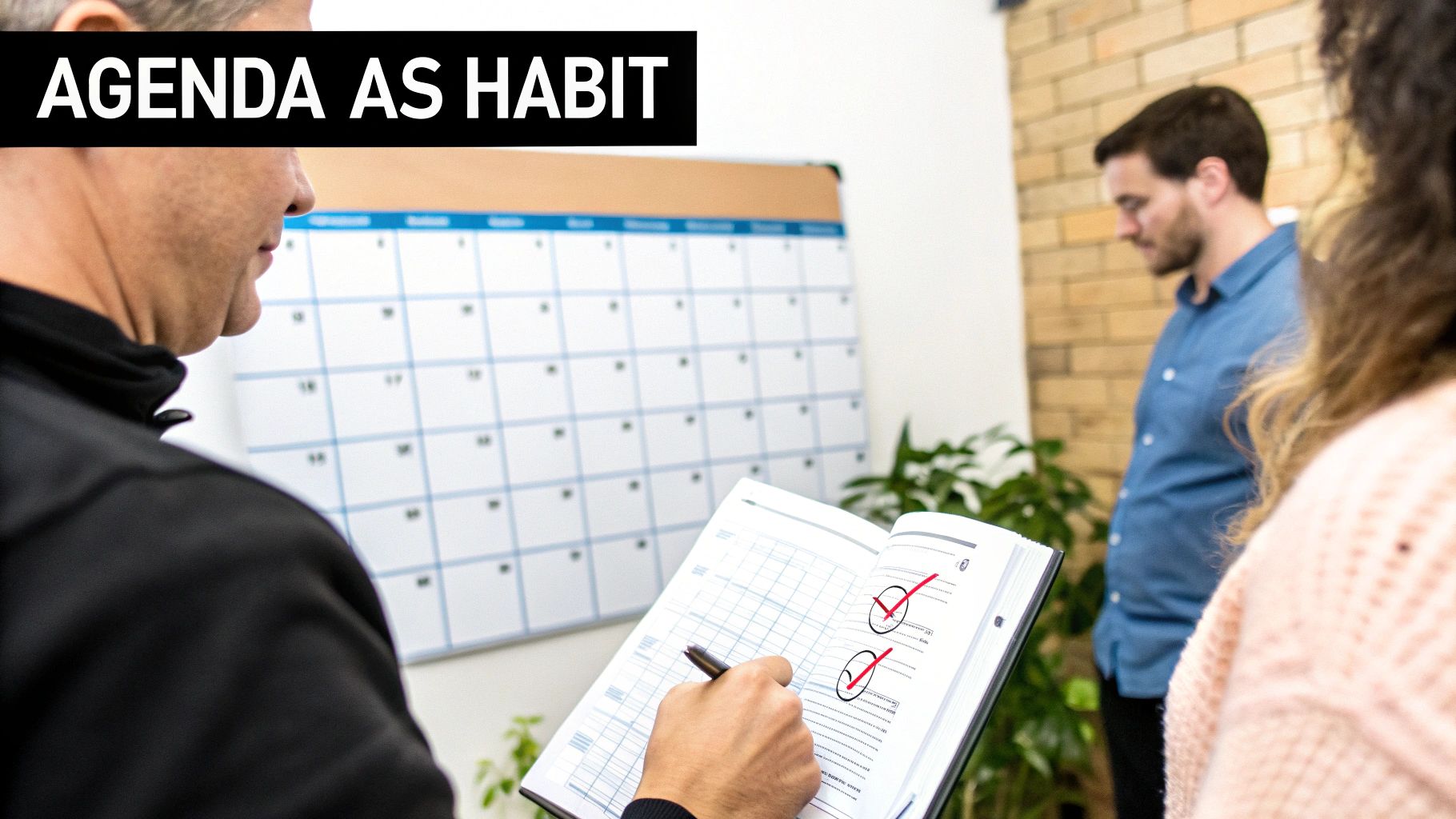
The best way to get everyone on board is to frame it as a tool that respects everyone’s time. This is especially true as more teams focus on making their in-office days count. For example, with California's office attendance rates still catching up to national averages, many companies are leaning on structured agendas to ensure that face-to-face time is as valuable as possible. You can read more about how California businesses are adapting on latimes.com.
Foster Collective Ownership
To really get your team invested, you need to lead by example and genuinely ask for their input. Think of the first few weeks as a test run and make it easy for people to share their thoughts.
- Ask for contributions: Actively encourage everyone to add their own agenda items before each meeting. This gives them a stake in the outcome.
- Seek honest feedback: Right after a meeting wraps up, ask a simple question: "What worked well with this agenda, and what could we tweak for next time?"
The goal isn't to roll out a perfect document from day one. It's about collaboratively building a habit that actually serves the team's goals and makes every single meeting more effective.
And don't underestimate the power of a little positive reinforcement. Celebrating a string of focused, productive meetings with a team lunch is a fantastic way to solidify these new habits. Great food brings people together and shows you appreciate their effort, which is why having a go-to for corporate catering can make all the difference.
Got Questions? We've Got Answers
Thinking about how to make these agenda templates work for your team? You're not alone. Here are some of the most common questions we get from managers and teams who are ready to make their meetings matter.
How Far Out Should I Send the Agenda?
For a standard weekly team sync, sending the agenda 24 hours in advance is perfect. It gives everyone a chance to look it over and come prepared, but it's not so far in advance that it gets buried in their inbox.
Now, if you're planning a bigger, more strategic session—like a quarterly review or a project kickoff—you'll want to give people more runway. For those, aim for at least 48 hours, especially if there's pre-reading involved. The whole point is to give your team enough time to do some real thinking beforehand.
What's the Best Format for a Meeting Agenda?
Honestly, the best format is the one your team will actually use. Don't overcomplicate it. A shared Google Docs file, a simple page in Confluence, or a template in Notion are all fantastic options because they're collaborative and easy to access.
Whatever tool you choose, make sure the format clearly lays out:
- The one key objective you need to achieve in this meeting.
- Who's attending and what their role is.
- Each topic with a time limit and a designated owner.
- A clear space to jot down action items as you go.
How Do I Keep the Meeting from Going Off the Rails?
Your agenda is your best friend here. It's the roadmap that keeps everyone heading in the same direction. When the conversation starts to wander, it’s the facilitator’s job to gently guide it back.
A simple phrase like, "That's an interesting point, but let's add it to the 'parking lot' for now to make sure we get through our main topics," works wonders. It validates the person's contribution without letting the entire meeting get sidetracked.
Who's Actually in Charge of Making the Agenda?
Officially, it's the meeting organizer's responsibility. But the most powerful agendas are the ones built by the whole team.
Create a culture where anyone can add relevant discussion points to the shared document before the meeting. When people contribute, they're more invested in the outcome. It also guarantees you're talking about what really matters to the team, not just what the leader thinks is important.
Ready to keep your team energized and appreciated? Shawarma Moose delivers stress-free, unforgettable corporate catering across Toronto. Explore our catering options and get a custom quote today!
